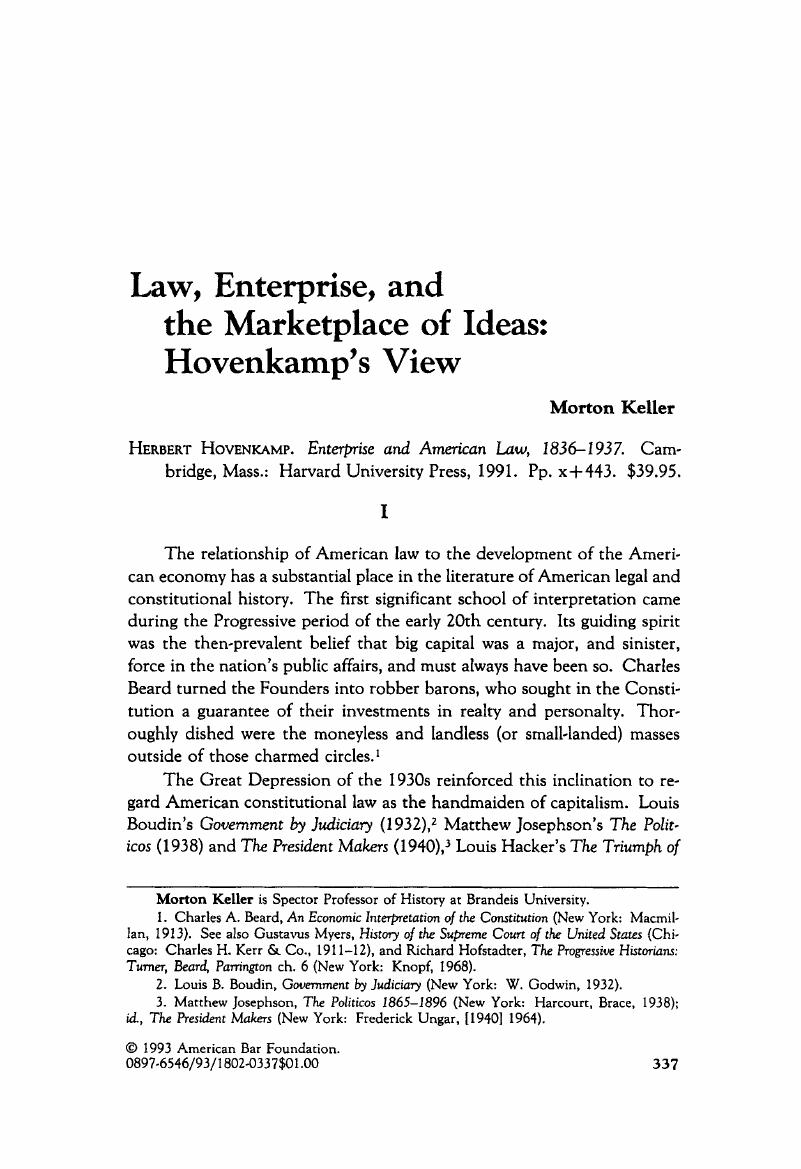No CrossRef data available.
Published online by Cambridge University Press: 27 December 2018

1 Charles A. Beard, An Economic Interpretation of the Constitution (New York: Macmillan, 1913). See also Gustavus Myers, History of the Supreme Court of the United States (Chicago: Charles H. Kerr & Co., 1911–12), and Richard Hofstadter, The Progressive Historians: Turner, Beard, Parrington ch. 6 (New York: Knopf, 1968).Google Scholar
2 Louis B. Boudin, Government by Judiciary (New York: W. Godwin, 1932).Google Scholar
3 Matthew Josephson, The Politicos 1865–1896 (New York: Harcourt, Brace, 1938); Id., The President Makers (New York: Frederick Ungar, [1940] 1964).Google Scholar
4 Louis Hacker, The Triumph of American Capitalism (New York: Simon & Schuster, 1940).Google Scholar
5 Thomas C. Cochran & William Miller, The Age of Enterprise (New York: Macmillan, 1942).Google Scholar
6 Finley Peter Dunne, Mr. Dooley on the Choice of Law, comp. Edward J. Bander, at 64 (Charlottesville, Va.: Michie, 1963).Google Scholar
7 Oscar & Mary Flug Handlin, Commonwealth: A Study of the Role of Government in the American Economy: Massachusetts, 1774–1861 (New York: New York University Press, 1947) (“Handlins, Commonwealth”).Google Scholar
8 Louis Hartz, Economic Policy and Democratic Thought: Pennsylvania, 1776–1860 (Cambridge, Mass.: Harvard University Press, 1948) (“Hartz, Economic Policy”).Google Scholar
9 James Willard Hurst, Law and the Conditions of Freedom in the Nineteenth-Century United Stares (Madison: University of Wisconsin Press, 1956). See also the Hurst-led series on the legal-economic history of Wisconsin, most notably Lawrence M. Friedman, Contract Law in America (Madison: University of Wisconsin Press, 1965), and James Willard Hurst, Law and Economic Growth: The Legal History of the Lumber Industry in Wisconsin 1836–1915 (Cambridge, Mass.: Harvard University Press, 1964).Google Scholar
10 Gabriel Kolko, The Triumph of Conservatism: A Reinterpretation of American History, 1900–1916 (Glencoe, Ill.: Free Press, 1963); Id, Railroads and Regulation 1877–1916 (Princeton, N.J.: Princeton University Press, 1965).Google Scholar
11 Morton J. Horwitz, The Transformation of American Law, 1780–1860 (Cambridge, Mass.: Harvard University Press, 1977).Google Scholar
12 Horwitz, Morton J., “The Rise of Legal Formalism,” 19 Am. J. Legal Hist. 251 (1975).CrossRefGoogle Scholar
13 Alfred D. Chandler, Jr., The Visible Hand: The Managerial Revolution in American Business (Cambridge, Mass.: Harvard University Press, 1977).Google Scholar
14 Simpson, A. W. Brian, “The Horwitz Thesis and the History of Contracts,” 48 U. Chi. L. Rev. 533 (1979); Schwartz, Gary T., “Tort Law and the Economy in Nineteenth Century America: A Reinterpretation,” 90 Yale L.J. 1717 (1981); McClair, Charles J. Jr., “Legal Change and Class Interests: A Review Essay on Morton Horwitz's The Transformation of American law ,” 68 Cal. L. Rev. 382 (1980).CrossRefGoogle Scholar
15 Martin J. Sklar, The Corporate Reconstruction of American Capitalism, 1890–1916: The Marker, the Law, and Politics (Cambridge, Eng.: Cambridge University Press, 1988).Google Scholar
16 Morton Keller, Regulating a New Economy: Public Policy and Economic Change in America, 1900–1933 (Cambridge, Mass.: Harvard University Press, 1990) (“Keller, Regulating a New Economy”). See also id., Affairs of State: Public Life in Late Nineteenth Century America (Cambridge, Mass.: Harvard University Press, 1977) (“Keller, Affairs of State”).Google Scholar
17 Hovenkamp at 6; Lawrence M. Friedman, A History of American law 339–41 (2d ed. New York: Simon & Schuster, 1985).Google Scholar
18 John Maynard Keynes, A General Theory of Employment, Interest, and Money 383 (New York: Harcourt, Brace, 1936).Google Scholar
19 Slaughterhouse Cases, 16 Wall. 36 (1873).Google Scholar
20 Dr. Miles Medical Co. v. John D. Park & Sons Co., 220 U.S. 373 (1911).Google Scholar
21 See Handlins, Commonwealth; Hartz, Economic Policy; Ronald E. Seavoy, The Origins of the American Business Corporation, 1784–1855 (Westport, Conn.: Greenwood Press, 1982).Google Scholar
22 Marshall in Bank of the United States v. Deaveaux, 9 U.S. (5 Cranch) 61, 86 (1809).Google Scholar
23 Louisville, Cincinnati & Charleston Railroad Co. v. Letson, 43 U.S. (2 How.) 497, 557–58 (1844).Google Scholar
24 Charles River Bridge Co. v. Warren Bridge, 36 U.S. (11 Pet.) 420 (1837).Google Scholar
25 Joyce Appleby, Liberalism and Republicanism in the Historical Imagination (Cambridge, Mass.: Harvard University Press, 1991).Google Scholar
26 For the traditional view, see Arnold M. Paul, Conservative Crisis and the Rule of Law: Attitudes of Bench and Bar, 1887–1895 (Ithaca, N.Y.: Cornell University Press, 1960). Reinterpretive statements include Michael Les Benedict, “Laissez-Faire and Liberty: A Re-evaluation of the Meaning and Origins of Laissez-Faire Constitutionalism,” 3 Law & Hist. Rev. 293 (1985); and Charles W. McCurdy, “Justice Field and the Jurisprudence of Government Relations: Some Parameters of Laissez-Faire Constitutionalism, 1863–1897,” 61 J. Am. Hist. 970 (1975). See also Keller, Affairs of State chs. 9–11 (cited in note 8).Google Scholar
27 Santa Clara Co. v. Southern Pacific R.R., 118 U.S. 394 (1886).Google Scholar
28 Horwitz, Morton, “ Santa Clara Revisited: The Development of Corporate Theory,” 88 W. Va. L. Rev. 173 (1985).Google Scholar
29 Horwitz, , 88 W. Va. L. Rev. at 208–9.Google Scholar
30 Edward S. Corwin, The Twilight of the Supreme Court ch. 1 (New Haven, Conn.: Yale University Press, 1934).Google Scholar
31 Swift V. Tyson, 41 U.S. (16 Pet.) 1 (1842). Hovenkamp's discussion of Swift is notable for its clarity and insight. Id. at 83–89.Google Scholar
32 Slaughterhouse Cases, 83 US. (16 Wall.) 36 (1873).Google Scholar
33 For a recent example of a class struggle interpretation of labor decisions, see William E. Forbath, Law and the Shaping of the American Labor Movement (Cambridge. Mass.: Harvard University Press, 1991). See also Karen Orren, Belated Feudalism: Labor, the Law, and Liberal Development in the United States (Cambridge, Eng.: Cambridge University Press, 1991).Google Scholar
34 United States v. E.C. Knight Co., 156 U.S. 1 (1895).Google Scholar
35 Keller, Regulating a New Economy chs. 2–5 (cited in note 16).Google Scholar